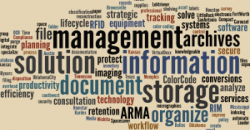Posts Tagged ‘scanning documents’
Improving Your Information Management System with DMAIC Planning
Improving Your Information Management System
 Where do you start when you need to create and/or improve your current records management system? Southwest Solutions Group has a standardized improvement model that provides your team with a consistent road map to develop or upgrade your records management system. The Define, Measure, Analyze, Improve, and Control (DMAIC) model is a structured rigorous approach to process improvement where each phase is logically linked to the previous phase as well as the next phase.
Where do you start when you need to create and/or improve your current records management system? Southwest Solutions Group has a standardized improvement model that provides your team with a consistent road map to develop or upgrade your records management system. The Define, Measure, Analyze, Improve, and Control (DMAIC) model is a structured rigorous approach to process improvement where each phase is logically linked to the previous phase as well as the next phase.
10 Steps to Converting Electronic Medical Records (EMR)
Why Electronic Medical Records (EMR)?
 Healthcare providers all across the U.S. are migrating their medical charts to Electronic Medical Records (EMR) to increase record accuracy, decrease waste, eliminate costly storage space, and improve patient care. Hospitals are also seeking to take advantage of government incentives under the American Recovery and Reinvestment Act (ARRA). Right now, everyone is focusing on the “carrot” of payments they can receive by implementing EMR. But the “stick” comes out in 2015, when hospitals that don’t meet federal guidelines for paperless records may be penalized with reduced Medicare reimbursements.
Healthcare providers all across the U.S. are migrating their medical charts to Electronic Medical Records (EMR) to increase record accuracy, decrease waste, eliminate costly storage space, and improve patient care. Hospitals are also seeking to take advantage of government incentives under the American Recovery and Reinvestment Act (ARRA). Right now, everyone is focusing on the “carrot” of payments they can receive by implementing EMR. But the “stick” comes out in 2015, when hospitals that don’t meet federal guidelines for paperless records may be penalized with reduced Medicare reimbursements.
What’s Holding Healthcare Organizations Back from Using EMR?
 The new government rules to EMR are confusing and picking the right document imaging software system is challenging. Plus, there is significant expense and disruption involved when you make such a big change in how medical records are handled. It’s just not feasible to expect hospitals to do this on their own without expert guidance from information management professionals. Software vendors are happy to sell you imaging hardware and advise you on how to install image software on your computer network; but that doesn’t help with the real-life obstacles you will face in converting your medical file charts to electronic images that can be located when you need them.
The new government rules to EMR are confusing and picking the right document imaging software system is challenging. Plus, there is significant expense and disruption involved when you make such a big change in how medical records are handled. It’s just not feasible to expect hospitals to do this on their own without expert guidance from information management professionals. Software vendors are happy to sell you imaging hardware and advise you on how to install image software on your computer network; but that doesn’t help with the real-life obstacles you will face in converting your medical file charts to electronic images that can be located when you need them.
 Getting Help Converting Electronic Medical Records
Getting Help Converting Electronic Medical Records
Converting medical records to a document imaging system takes the help of a qualified information management specialist who has experience in the EMR imaging process and government requirements. A qualified information management specialist will help you understand the process and avoid common mistakes that can set your organization back. For example, EMR compatible medical records scanning involves more than simply scanning records and uploading a pdf of a patient’s chart into a database. If you don’t have federally approved quality controls in place, you may end up with a bunch of electronic records that are not considered true originals. That’s an excuse Medicare can use to deny payment. Below is an overview of ten steps to converting your medical documents to Electronic Medical Records.
10 Steps to Converting Your Paper Medical Records to EMR
1. Survey – Review your current filing system to discover the best documents to image 2. Plan – Develop a master plan to map and document every step of the conversion process including establishing your document indexing requirements 3. Pack & Manifest – Box and label medical charts/records to be imaged so they can be tracked throughout the conversion process 4. Secure Transportation – Ship record boxes with documents to be scanned and imaged via a bonded courier directly to a secure image conversion facility 5. Validate Receipt – Have the image conversion facility provide receipt of shipment and confirmation documentation of all documents are present 6. Prep & Scanning – The image conversion contractor should prep documents, removing staples and repairing any damaged records before scanning documents with a high quality production scanners to ensure a high quality, clear and complete scan of each file 7. Indexing – Document The image conversion contractor should index documents according to your specifications established in Step Two 8. Quality Control – Request a sampling of imaged documents to ensure scanning and indexing accuracy of each record 9. Output – Upload the scanned records into your EMR software system or supply on CD/DVD if requested 10. Store or Shred – Provide storage, shredding, or secure shipping instructions for paper records



